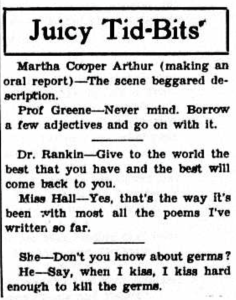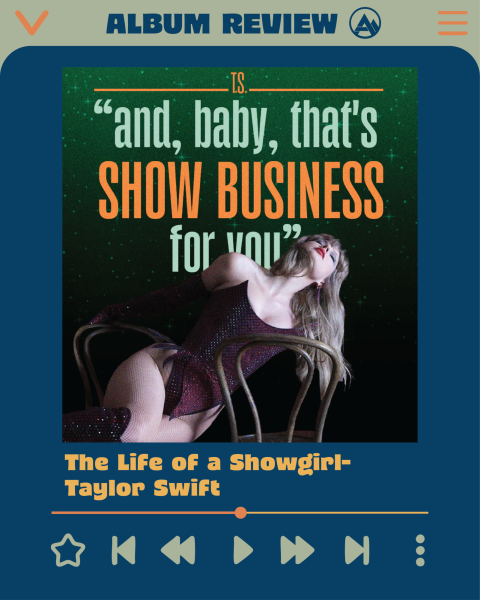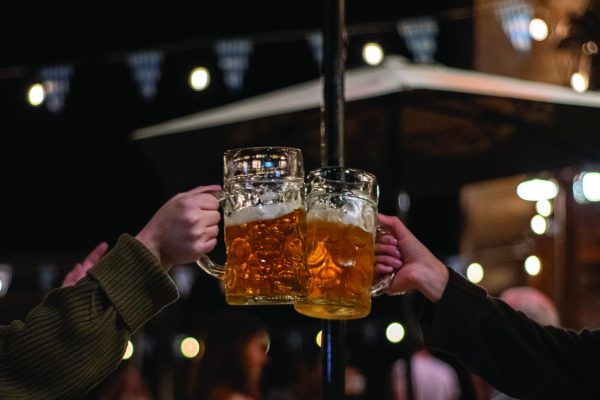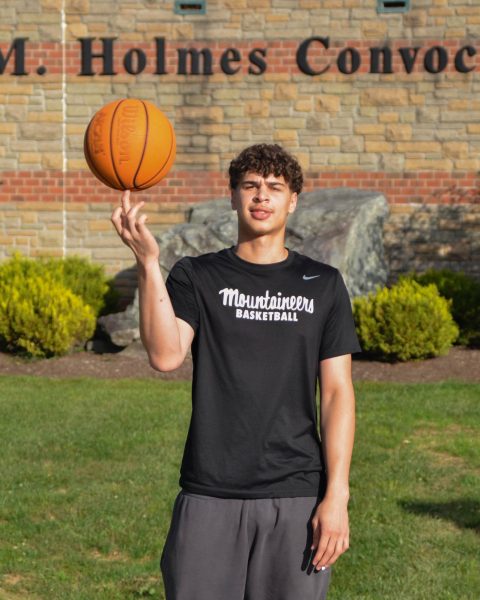OPINION: Rosalia: A case study in cultural appropriation
September 20, 2019
One of the most popular Hispanic artists in the world won two of this year’s Latin Grammy’s, but instead of congratulations, she’s faced with major controversy.
Rosalia’s 2018 album “Malamente” won Best Urban Fusion and Best Alternative Song and her popularity is well-deserved — listening to her music is like listening to music from both the past and the future. The album is a profound and unprecedented fusion of traditional flamenco and urban music. It quickly rose to the top of English and Spanish charts.
The catch, however, is that Rosalia should have never received a Latin Grammy. Rosalia is not Latinx.
Latinx, Latino and Latina all refer to cultural identities of Latin origin and geography: specifically, regions of North America, the Caribbean, Central America and South America.
Rosalia is from Spain. Spain is not Latin; Spain is Hispanic. This is an important but often overlooked discrepancy. Furthermore, Rosalia’s use of flamenco, an art form she studied extensively, is controversial. Flamenco is from Andalusia, a southern region of Spain, whereas Rosalia is from Catalonia, a region that has historical tensions with the rest of the country. Some wonder if Rosalia’s affinity for flamenco and a more Latinx identity is less cultural appreciation and more cultural appropriation, a growing global issue in the music industry.
Promoting a false sense of what it means to be Latin and using it to one’s own advantage, otherwise known as cultural appropriation, is disrespectful to the artists who work hard to represent their culture in a global setting.
Hispanic music is already very popular. There is no shortage of Eurocentric celebrities, especially in the music industry. Continuing culturally inaccurate branding erases opportunities for diversity.
It’s like when Justin Bieber’s remix of Luis Fonsi and Daddy Yankee’s “Despacito” pushed the original out of the charts. Rosalia’s music is taking up space that could be filled by real, unique Latinx artists who are often dismissed.
“Mia,” the 2018 Spanish hit by Puerto Rican rapper Bad Bunny, was popularized by Drake’s involvement on the track. “Mi Gente,” an early J. Balvin hit popular in 2017, made an increased appearance in the charts after Beyonce’s involvement in a remix. And, Benny Blanco, a white rapper, has created a Latino brand for himself to gain popularity through collaborations, such as the 2019 hit “I Can’t Get Enough,” which features Tainy, J. Balvin and Selena Gomez.
In the case of Rosalia, her popularity as a “Latina” artist suggests that a eurocentric pop star is far more likely to achieve global success than artists who look, sound and actually are Latinx. J. Balvin, an authentic Latino artist, has never won a Latin Grammy, yet he’s credited with the success of the modern Latin pop industry.
Ozuna, a popular Latino artist, is featured on “Yo Por Ti, Tu Por Mi,” Rosalia’s latest song. He owns the second-most hits on Latin Charts this year but has received neither the awards nor popularity that Rosalia has.
This does not mean Rosalia and other eurocentric artists should not be appreciated for their successes. Instead, their music should be listened to and enjoyed outside of a Latin context to fully support the culture and history that helped make them famous.
Maybe once Latin music charts are no longer dominated by Hispanic, eurocentric celebrities, there will be room for works by important, culturally accurate musicians who also deserve their chance.












Paul • Aug 30, 2024 at 12:10 am
To make very long paper shorter, the system I use for a database is:
American: anyone in America before Colombo
Columbian: anyone that arrived since Colombo
Americaner: any Columbian who is a citizen of a Columbian nation
British Columbian: Columbians from Britania
Spanish/Hispanic Columbian: Columbians from Spain/Hispania
[Tribe] Americaners: Americaners of [certain] tribe
(e.g. Anglo Americaner: Americaner of Anglo tribe)
[Language] American: Americans with [certain] first language
Spanish American: American whose first language is Spanish
(e.g. Navajo American: American whose first language is Navajo)
Extra Information
Latini: a tribe of Italian peninsula
Latin: language of Latini
Latium: land of Latini
Latini, with help of Greek (Hellenes), established Roma.
Roma grew into a large nation that influenced many others.
Roman: “citizens” of Roma (not Latini)
Orient: east of Italian peninsula (East Hellenic Roma after split)
Occident: west of Balkan peninsula (West Latin Roma after split)
Asia: East of Greece (from Asu: East of Akkad in today’s Iraq)
Evropa: West of Greece (from Ereb/Arab: West of Akkad) originally including only Italian peninsula and shores along Mediterranean Sea but currently including North of Mediterranean Sea within Occident)
Hispania: West of Pyrenees Mountains in European peninsula, later used as a name of a country
Victoria Kabeya • Feb 12, 2023 at 8:00 am
You got it all wrong. We talk about LATIN AMERICA because colonizers named the spaces after them. If you go to Native countries such as Peru, Ecuador or Bolivia, you will find millions of Natives who will reject the label “HISPANIC” and “LATINO”. Do you wanna know why? Because the original LATINOS are the Portuguese, the French, the Spaniards, the Italians and even the Romanians. Rosalia, this mf thief and colonial agent in music, is THE REAL LATINA. The US Latinos were COLONISED by the LATINS, but they are either of Native, Afro-Indigenous, African or European descent submitted to LATIN culture.
Nuno • Jan 31, 2023 at 9:46 pm
Spain is most definitely latin. The only latin countries are in South Europe.
Latino ≠ Latin.
Latino countries are in South America.
Latin countries are Portugal, Spain, France and Italy. (Not including the 5 micro-nations)
Dolando • May 8, 2022 at 8:23 am
Great ideas here. Genres and musicians need to be cleanly labeled and divided. We must mix in diversity like we are baking a cake – pulling ingredients deliberately from their cleanly labeled jars. Or we could, idk, let artists mesh and mold their music together as a global community.
Robin • Mar 25, 2022 at 7:59 am
I could never understand why western people are always overreacting to this kinda situation lol Stupid PC… I would definitely be glad if a foreigner wanna learn my culture. Moreover, both flamenco and Rosalía are from Spain duh. Nowadays flamenco represents not only Andalucía but also Spain. On condition that she identifies herself as Spanish, it’s totally fine for her to represent the culture of her mother country.
Dee • Mar 7, 2022 at 11:19 am
Unpopular opinion, Rosalia’s 2018 album is titled “El Mal Querer,” not “Malamente.” 🙂
Antonia • Oct 2, 2021 at 8:16 pm
Latina/Latin/Latinx, not matter how your try to bend it is one culture. One area. Latium, also know today as Lazio. People from Lazio can call themselves Latina/o and they would be accurate. Someone from Toscana/Tuscany is not a latino, they are Toscana or even Etrusca or Etruscan.
The only people speaking the true language of Latin today actually live in a small area Switzerland (crazy right?). So Italians don’t complain that people of South America have (mis) appropriated themselves, they just kind of giggle. Sort of like, “let em take the name of their conquerers, Viva la Roma!” I say let em use it. It’s appropriation in its truest me dominating form.
I’m an American Italian with Tuscan roots, not calling myself a Latina. My Roman cousin considered it (who literally can be called a Latina), but then laughed and said “No, they’ll think I’m from South America or something.” Hmmm.
Lola • Oct 5, 2022 at 5:57 am
People in Latin AMerica did not “appriopiate” the term Latin American, it was imposed on people of the Americas by the French… Bonaparte wanted “Latin America” to be part of his french empire… Might wanna read up on that… Most Latin Americans are indigenous, Black and mixed race, with a white immigrant population, some left from colonization and others from all the wars in Europe… Rosalia is a cultural apprioator, because she did NOT grow up with Roma people nor Latin American people… She appropriates the “black culture” of latin america without actually giving anything back to the culture… Just as White singers have done with Black American culture. It is NOT OK. Great article.
Roberto • Dec 1, 2022 at 6:57 am
She never acknowledged she was latinx, but has only said she felt latina when travelling in Latin America. Plus, sweeping Latin Grammy doesn’t mean she identifies herself as Latin American. “Latin” doesn’t equal to Latin American bruh. I mean, cmon, it’s just “Latin”, not something like “latinx”, “Latino” or “Latina”! Why does this word always have to be associated with the America continent? “Latin” language and culture originated in south Europe, now people from which are not allowed to say they are Latin? You guys are too much.
Anca • Aug 25, 2021 at 11:04 pm
@Lu I think you reffeer to Gypsies, not Romanians. Gypsies are a minority, that migrated from India, Punjab centuries ago, all over the Balkans not just Romania. Romanians are an ethnic white European group, their ascensors being Dacians and Romans. The indigenous white people of Romania.
Manuel • Dec 2, 2020 at 12:56 pm
As an African, Portuguese descent, resident in the USA, I consider myself a macho Latino.
The concept that all Africans are black all Latinos are Spanish brown and all Americans are John Wayne white is ignorant to say the least.
I consider this argument of cultural appropriation a double-edged sword. should we forbid Americans from Kizomba? how about merengue and samba? in fact, most of the most popular music in Latin America should be banned because all of these rhythms came from Africa. How can there be innovation if not by appropriation and modification. As long as it is done with respect, cultural appreciation, and you do not decide to rewrite history, then party on.
If you want to exclude Americans (Brazilians and French Latin Americans) Europeans, Africans and even Asians from considering themselves Latinos or of Latin culture, Call it Latin American Spanish only “Latams”. Sorry if you are from Paraguay, Bolivia, El Salvador or anyplace where Spanish is not really spoken you are also out. let’s also exclude Argentina, Paraguay and Uruguay they are too much Italian.
And finally please let’s reserve Latinx to naming the group of people that believe they are Latinos but do not have much knowledge of the language and are culturally ambiguous.
Lu • Dec 1, 2020 at 7:50 pm
I lost respect for rosalia.. This whole issue shows how toxic western culture is. The term “Latino” as we know it has nothing to do with the Latin language. Ironically it was to distinguish Latin Americans from Europeans who speak the same language… to remind us we’re POC. We’ve embraced it bc yeah, our culture is completely different. We endured discrimination and now our music is being enjoyed worldwide. We are still fed this idea that we owe our culture to Europe… when our culture is obviously different… even our Spanish is different.
This obsession with glamorizing colonization needs to stop. Why should we be thankful for a genocide? Bc it gave us diversity? Their intention was not to create a thriving Latino culture. Our ancestors were killed; their cultures robbed, their contributions erased from our history. But their legacy lives on with latino culture. When ppl think of Latino culture, they’re thinking of Latin American. We owe our culture to our indigenous and African roots. Music was culturally important to them… colonizers looked down on this. The idea that Europeans brought civilization to the Americas is getting played out. Don’t tell me our music comes from Spain when Flamenco wasnt even a thing until the 1700s. Meanwhile we have popular music in our respective countries predating colonization. Flamenco was brought by romanian immigrants… the same ppl who still face discrimination in Spain. Looking down on the ppl but stealing their culture… how familiar.
And it’s exactly this false sense of superiority and entitlement that is extremely toxic. W. Europe cannot acknowledge they benefitted the most from colonization. Things credited to western culture were practiced by other civilizations for centuries before. The riches taken from the americas put them in a position to spread misinformation. We’re taught about the “scientific revolution” as if these concepts werent already practiced for centuries by other civilizations. The nerve to claim superiority over the civilizations (i.e China and India) where these ideas came from. But it’s what defies western culture… even in 2020. I don’t know why I expected more from Rosalia and other Europeans
Lola • Oct 5, 2022 at 5:59 am
Thank you Lu!!! Beautifully said!!! LETS SPEAK ON IT MORE!!!
Valeria • Oct 31, 2020 at 10:16 pm
The fact that in a continent (America) the meaning of a word that originated in other continent (the European) has changed because they just wanted doesn’t mean that it’s correct and we have to change it too. While USA changed the meaning of latino/latina/latini we were studying who where and are the Latin countries in Europe and sometimes we still use this adjective to talk about their culture, qualities or similarities…
We still use this word, that we created to describe these European culture. You can’t just say oh another country has changed the meaning of a word that describe a whole culture let’s change it all over the world. NO! It’s not correct. Latin/latino/latina/latini it’s used to talk about culture in Europe and Latam can use it also to say that latin it is part of their culture too, because their Native American culture mixed with our Latin culture. But they can’t say we are not latinos, because we are.
And Latam should fight for be called Americans, and be proud that it’s culture comes from Native Americans, and America is the continent, like we will do with being Latin.
Juan • Sep 19, 2020 at 1:00 pm
Many of you are in fact right when you point out the real meaning of latino. So sure, in theory Spainards, Portuguese, Italians, French, etc. are indeed Latins, however as centuries have passed the way in which the word is used by everyone, not just you people from the US (which think you can ignore all the other countires in the Americas and call yourselfs America and then don’t bother to teach your people world geography correctly), it has changed meaning. In way that you people might understand a little better, Rosalia calling herself “Latin” is like me calling myself “American”. Sure, I’m not from the US but I am from South America, doesn’t that rightfully entitle me to describing myself as an American? yes it does, but I’m using this example since to you gringos, it might make sense, and some of you probably don’t even know there’s a continent, or half of one (whichever you think) that is called South America. And no, gringo is not a racial slur or racist, so don’t argue about somthing you don’t even know, and it is most definetly better than calling you Americans, becaus that’s insulting to the rest of American countries. The point is that Rosalia is a white European, she does not, by any means represent what the world “Latin” means in today’s world, she is not what is known as a latin composer, that she thinks she is and that you guys think she is, is also insulting. She does mke good music, she’s simply not a “Latin” in today’s terms. If you think she is, you should consider giving Hugh Jackman or Ryan Reynolds an award for best US actor since you all came from countries that were once Britrish colonies, therefore your countries the same. (I know some of my points are flawed, however my goal was to let the gringos now, so I made slightly dumb points so that they might be able to understand how bad it is that Rosalia got a “latin” award)
Valeria • Sep 3, 2020 at 4:42 am
This whole article is forgetting the original meaning of the word latino, which is not about skin colour like america started using wrongly in the past. Latino its about a culture: architectire, language, clothes, religion, style of life, cooking, music….a lot of different ethnicitys under the roman empire culture which spread all over europe and even north africa. If the award show its for latino and not latam people all the other countries that were under the roman empire are included too… They also say Rosalia is hispanic…yes she is, she is ibera, hispanic, latina and spanish…but let’s not forget hispanic its not only people from spain its people from hispania (included portugal). And if latam people consider themselves latinos because we went there they should also consider themselves hispanic too…(also brazil). They are just changing the meaning of the historical and cultural meaning.
Also thought even latam people has been influed by latino towns they have their distintive cualtities (because of the native american past) so if they say its an award just for these qualities why dont call the show latam awards not latino awards which include a huge range of countries. It have no sense!
Nya • Jun 23, 2020 at 6:30 pm
She is not Latinx nor Hispanic either. She is Spanish/European, if anything the terms used from her Catalonian roots are appropriate but she is NOT Hispanic.
V • Apr 5, 2022 at 5:37 am
Hispanic comes from Hispania. That is what the Romans called Spain, Hispania drop the H = Ispania leave it a few centuries and
España (pronounced a bit like Espania). How exactly is she not Hispanic? Before you say Catalans have their own Language every region in Europe had regional languages, Spain, Italy, France, Germany.
Rachael • Jun 15, 2020 at 9:35 am
I couldnt agree more. Rosalias free to appropriate her own countries music. When it comes to the historical racism and classism and eurocentrism in Latin America only realises itself in the context of her notiety, rise to success, the endoresement of yet another White Appearing Artist in the so called Latin music scene. Rosalias usage of “urban” culture to somehow justify her grills or her usage of black American trap artists or South American artists like Jbalvin in music that is so far from her own. It is clear her conscience of the music she uses from her homeland and the music she sings with on for S. American artists is directly related to race. Not to mention, despite the several decades of the American Grammyd and the plethora of S.American, Mexican artists who have garnered strength and platform in the US charts, she was the first to ever perform in Spanish. Even Selena one of the most successful female Mexican artists of all time wasnt allowed her 5 min on the Grammy stage. There is an absolute abhorrent failure of Latin/S.American entertainment industries of inclusion and diveraity. Because if per sé Rosalia were Indigenous or Black would her success have been as profound? Caste systems Spanish brought never left S. America and is the very reason Cuarón nearly cut Spain Netflix from airing his movie Roma because Spain was adding spanish subtitles on the Mexican Spanish. As if Spanish couldnt understand the lower class colonized people of Mexico. It is very clear that women like Yalitizia were never destined for the spotlight like many indigeous people of S.America. Let us not forget that she is definitely in a glass ceiling scenario. She just needed the right people, rather than her having to struggle w racism or classism.
Barry Boud • Oct 3, 2019 at 1:24 am
Neils comment above is spot on!
This article is just spreading ignorance.
John McAdams • Oct 2, 2019 at 8:07 pm
What a bunch of nonsense. The blues is “black music.” So when Eric Clapton jams with B.B. King, is he guilty of “Cultural Appropriation?”
Check out the following clip:
https://www.youtube.com/watch?v=RzngbuoJSXo&feature=youtu.be&t=97
B.B. King doesn’t seem to mind jamming with Clapton. But he was just the greatest of all blue men. What does he know, compared to you leftist professor of “diversity” trainer?
Sebas • Sep 22, 2019 at 1:42 pm
Rosalia maybe culturally appropriating the gitano culture, in this case flamenco. But we must understand that Rosalia has no intention of attacking the gitano culture. She studied flamenco at the university before even starting to progress in the music industry. She knows very well this music genre hence she shows it in her music and is very fond of it. Now the issue is she presents the flamenco music in a way that can be misinterpreted and obviously be taken as cultural appropriation, as the gitanos have noted she does not have full respect or knowledge to say words that are sacred to gypsies such as undive, meaning god in romani. But again its all a controversy regarding cultural backgrounds, pride, persecution. Her music should be simply enjoyed. Rosalia should be taken on the same note as for example her ex boyfriend, Tangana, a Spaniard rapper, or just modern Spaniard artists. The difference is Rosalia is all about success and she plans to collaborate and spread her talent in genres she is curious in. The issues between her and gitano artists of flamenco should settle the issue, although music genres is not owned by anyone, they strongly represent cultures. Spain may seem as a wholesome, unified country culturally, but it is very separated .
Neil Blanco • Sep 20, 2019 at 3:24 pm
I’m afraid that the opinions expressed in this article are extremely “American-centric”. The misunderstanding arises from the fact that in North-America the term “latin” is used, as mentioned in the article, to describe people of South and Central American and Caribbean heritage. There is more of an emphasis on geographic origin with racial undertones, a statistical demographic, as opposed to seeing latin for what it should be, a cultural construct based on language and shared bonds that stretch across both sides of the pond, sadly with origins in empire.
Has anyone stopped to consider the origin of the word “latin”? I am convinced you are aware that latin was spoken by romans, who spread their language across much of Europe through their empire. All the romance languages of Southern Europe derive from latin and thus the populations of countries in which these modern day languages are spoken consider themselves culturally latin. Indeed, the most latin country of them all, by rights, should be Italy. To consider that only people of American origin have an exclusive right to call themselves latin, latino or latinx, is denying European latins their cultural heritage. Forget cultural appropriation, I see this as cultural exclusion. Latin Americans have received, (or should I say sadly had it imposed on them), their latin heritage through the Spanish and Portuguese empires. So given that latin is a linguistic and cultural as opposed to a racial construct it is therefore wrong in my opinion to suggest that Rosalia, or any other European latin artist, shouldn’t be nominated in a latin music award category. At a slight risk of sounding pedantic, she wasn’t nominated under a latin-American category (which she most definitely isn’t) but just latin period. Irrespective of race or privilege, she IS latin.
Now there is a case to be made that Rosalia has culturally appropriated Flamenco from Andalucia and especially the ethnic gypsy population, (traditionally the ethnicity that is most discriminated against in Spain in all walks of life). However it should be noted that the effects of mass migration from Andalucia to Catalonia have somewhat blurred the lines and complicated matters, many arguing that Flamenco now forms part of modern day Catalonian popular culture. There have been political tensions between Catalonia and the rest of Spain, but in spite of prejudiced people on both sides, Catalonia by and large remains open-minded and liberal.
I’m not questioning the fact that Rosalia’s position of white middle-class privilege has placed her at an advantage over gypsy flamenco artists, but that comes down to historic racial, societal and systemic prejudices that have fed into economic disenfranchisement of gypsies. It will take generations to address and in the meantime perhaps government could boost funding for programs offering musical scholarships to people of a disadvantaged background.
I’m not disagreeing with the core message of your article, but rather the slant. Rosalia is Spanish and Catalonian, speaks in Spanish and Catalan, two romance languages derived from latin. She therefore is culturally latin. Shout it from the rooftops , “Rosalia IS latin”!